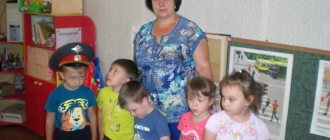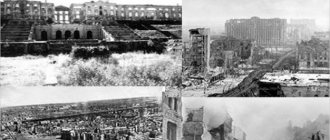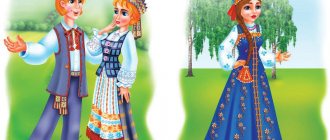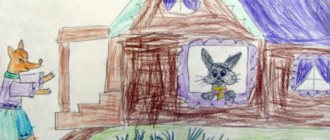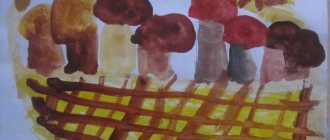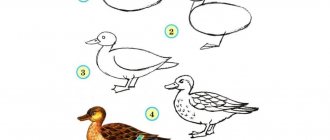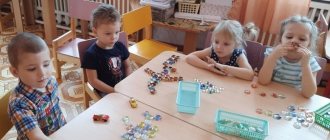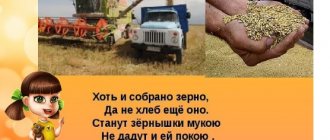Preview:
Department of General Education
of the Rtishchevsky District of the Saratov Region
Municipal preschool educational institution "Kindergarten No. 12 "Zvezdochka". G. Rtishchevo, Saratov region"
Topic: “Bread is the head of everything”
Educator: Kolomiets V.E.
Abstract drawing “Bread is the head of everything”
Goal: To teach children unconventional ways of drawing an ear of wheat.
expand and deepen children’s knowledge about a wheat ear and its appearance.
strengthen your drawing skills using brush bristles.
— increase the motivation of visual activity through awareness of its moral significance; improve gross and fine motor skills.
activate adjectives in children’s speech (yellow, prickly, golden).
Educational objectives: to cultivate independence and focus in work, the ability to complete a job started, accuracy when working with paints. Cultivate a caring attitude towards bread.
The teacher tells the ancient legend about the ear of bread:
— In ancient times, when God himself walked the earth, people’s lives were easy and well-fed. It was summer all year round. When needed, it rained, when needed, the sun shone. Fruit trees grew in the forests. The animals were docile, and all fed on grass. People knew no disease, no troubles, no hunger. The ear of grain was very large - there was almost no stalk, the grains started from the ground itself, and each grain was the size of a bean. There was so much bread that no one valued it. One day God walked the earth and saw how a mother wiped a soiled child with the edge of freshly baked bread and at the same time refused food to the wanderer. God got angry, ascended to heaven and deprived people of bread. The earth became like stone, the rivers dried up, the grass withered. Hunger has set in. Then the cat and dog went to God to ask for bread. He took pity and allocated a small ear on a long stem for the cat and dog's share. God made it so that summer began to occupy only half of the year. Winter is for people, and summer is for animals. When people baked fresh bread, they gave the first piece to cats and dogs. Now tell me, what does the legend teach?
Educator: guys, guess the riddle, “a house grew up in a field, the house is full of grain” (ear of grain). Here is the spikelet as our guest today, let’s tell you what we know about it. Where does the spikelet grow? What plants still grow in the field that have spikelets?
Children: wheat, rye, barley.
Educator: guys, let's look at the picture showing a wheat field. What's on the spikelet?
Children: grains (the teacher demonstrates a natural ear of wheat)
A grain has fallen into the ground (children crouch),
It began to germinate in the sun (arms above head).
The rain watered the ground, and the sprout grew (the children get up slowly).
He was drawn to the light and warmth, and turned into a handsome man.
Educator: children, let's sit down at the table and try to draw a wheat field (first we draw a stalk, and then blot the bristles of the brush.
The teacher asks the children to imagine that he is a spikelet, and they are grains. Children slowly gather in a circle on the carpet, with the teacher in the center.
— Guys, tell me what is made from wheat grains? (different types of flour)
-What are they made from flour? (bakery products)
- Today our spikelet has prepared bread for you.
grain field
After a lesson on introducing the professions of adults, in which children observed how bread is made and what kind of people are involved in the process of creating such a main product on our table, you can consolidate the material in a drawing lesson in the senior group. Drawing a grain field is not difficult, but some preliminary work will be required.
First, the day before class, you will need to paint a blue background so that the paint dries well. The next day, the guys are already drawing the wheat itself growing in the field. You can draw yellow, fully ripened spikelets, or you can depict green shoots.
Children in the older group are already learning to depict the movement of objects. Therefore, you need to explain to the children that the wind sways the spikelets and they tilt in different directions. They can also be drawn in a semicircle, lowered down. When the spikelet ripens, the grains become heavy and pull it down. The lower part of the picture is filled with sticks on which the grains are held. On top of the blue sky you can draw white clouds and the sun.
Preview:
Goal: to cultivate a caring attitude towards bread.
Objectives: to remind that bread is everyday
product; continue to learn to think about the content of your future drawing; develop the skill of drawing the outline of an object with a simple pencil with light pressure on it; consolidate the ability to paint over an image; develop imagination and independence.
Materials and equipment: illustrations and drawings on the topic “Bread”,
ears of rye, bakery products, flour, white sheets, simple pencils,
wax crayons, musical accompaniment.
1. Organizational moment.
- Guys, I’ll tell you a riddle now, and you guess it and find out what
Today we will draw.
Everyone calls him the head,
Never throw it on the floor.
In the oven he grew up and became stronger,
This is our favorite...(bread)
- Right. We will draw bread today. (Conversation with children). Let's
Let's look and touch our baked goods (examination). Pay attention to the shape, size, color.
The seed is growing (They squat, clasping their knees with their hands)
The seed is growing - (Squatting, hands pulled up)
Reached for the sun. (Stand up, stretch on tiptoes, hands up)
It plays with the breeze, (Hands up, swaying gently from side to side
The breeze shakes it
He presses low to the ground (Tilting towards his toes) - that’s how fun he plays!
(Straightened up, jumped, hands up).
Invite the children to put sheets of paper in front of them, take simple
pencils, specify that the drawing will be located
all over the sheet of paper.
- Guys, tell me, how will we draw with a simple pencil?
(Answers). Right. To begin with, we will draw an outline using a pencil
You need to press lightly.
When the main details of the drawing have been drawn, offer the children
take wax crayons and color.
4. Make an exhibition for parents.
5. Put workspaces in order.
On the topic: methodological developments, presentations and notes
Summary of a lesson in the senior group on the topic Bread is the head of everything.
I offer you a summary of open direct educational activities for children of the senior group on the topic: “Bread is the head of everything.” This material is useful for teachers of the senior group. Cognitive
let children understand that bread is a daily food product, introduce children to the variety of bakery products, consolidate knowledge about the long journey of bread from field to table, and educate uva.
Give children an idea that bread is a daily food product; introduce children to a variety of bakery products; consolidate knowledge about the long journey of bread from field to table; V.
Give children the idea that bread is a daily product. Tell where bread comes from, how it is made, who grows it and bakes it. To instill respect for the work of adults and respect for bread.
Source
Drawing in the senior group on the topic Bread: variations of themes, age-specific features
In kindergarten, each school week has its own specific theme. These could be domestic or wild animals, vegetables or fruits, birds or insects, transport or adult professions. One of the mandatory themes for all age groups is “Bread is the head of everything.”
All classes of the week reinforce this theme: speech development and familiarization with the environment and nature, conversations and observations. Art classes are also held on this topic. This week children draw baked goods, ears of corn and a wheat field.
In the article we will introduce parents to how drawing is carried out in the senior group on the topic “Bread”.
Bakery products
Starting from the younger group, children learn to draw various subject and plot pictures on the theme “Bread is the head of everything.” By the older group, they already have the skills to draw a symmetrical spikelet, buns and bagels. During the week dedicated to bread, you can plan an exhibition of bakery products with the older children.
The teacher can decide who will draw which baked goods, or the children themselves can decide if they wish. Then, on separate sheets of paper, the guys draw a loaf, bread, bagel, bun, loaf, bagels, donuts and braids, etc. Then all the variety is hung on a stand in the corridor. You can invite children of the younger group, parents, and kindergarten staff to the exhibition of works.
Meeting with guests
In our country there is a tradition, following which dear guests are greeted with bread and salt. They bring out a beautiful loaf on a clean embroidered towel.
With five-year-old children in the older group, drawing on the topic “Bread” can be done after the teacher tells about the loaf and looks at the illustrations of welcoming guests. Separately, the children are shown a sample of a beautiful embroidered towel.
Following the example of the teacher, children first draw a semicircle of bread with light brown paint. The top of the loaf is decorated with spikelets or flowers of the same color. A white towel is drawn below. After drying, its edges are painted with geometric or floral patterns. At the end of drawing, a salt shaker is placed on top. White salt can be made by dipping a cotton swab.
Bread in a basket
Drawing in the senior group on this topic can be planned as follows:
1. First, children depict a basket. This can be an ordinary product woven from twigs. The child first draws the contours with a simple pencil, dividing it into sectors. Only then are small details painted over, alternating light and dark elements with each other.
2. Then, after complete drying, the bread and bagel are painted, shading the curves of the products with a lighter shade.
3. You can insert several spikelets into the basket in the background. To do this, you need to draw with a simple pencil and then paint, also alternating colors.
Such drawing in the older group on the topic “Bread” can be done using colored pencils or wax crayons. Because there are a lot of small details.
Please note: if you want to draw such a picture at home with your child, then five-year-old children should already understand the spatial arrangement of objects. What is closer is drawn in a larger size, what is further away is drawn in a small size.
To draw a basket, use such an angle when the front of the wallet is located lower, not at the same level as the back side. The inside of the container is visible.
You can draw a handle for it, or you can put a napkin on the bottom of the basket and draw the corners of the fabric hanging from the middle of it.
grain field
After a lesson on introducing the professions of adults, in which children observed how bread is made and what kind of people are involved in the process of creating such a main product on our table, you can consolidate the material in a drawing lesson in the senior group. Drawing a grain field is not difficult, but some preliminary work will be required.
First, the day before class, you will need to paint a blue background so that the paint dries well. The next day, the guys are already drawing the wheat itself growing in the field. You can draw yellow, fully ripened spikelets, or you can depict green shoots.
Children in the older group are already learning to depict the movement of objects. Therefore, you need to explain to the children that the wind sways the spikelets and they tilt in different directions. They can also be drawn in a semicircle, lowered down.
When the spikelet ripens, the grains become heavy and pull it down. The lower part of the picture is filled with sticks on which the grains are held. On top of the blue sky you can draw white clouds and the sun.
Subject of drawing
As additional ideas for drawing in the senior group on the topic “Bread”, you can offer the following options:
1. Treats for dolls.
2. Tea party with bagels.
3. Easter holiday.
4. Sandwich for breakfast.
5. Favorite donuts.
6. We bake bagels for grandma.
You can fantasize for a long time, which allows for a variety of bakery products. You can draw a sheaf in a field or spikelets in a vase. The main thing is for children to learn that bread is an important product in a person’s life, so it needs to be protected and treated with respect.
Source: https://autogear.ru/article/360/581/risovanie-v-starshey-gruppe-na-temu-hleb-variantyi-tem-vozrastnyie-osobennosti/
Summary of a drawing lesson Topic: “Glory to the bread on the table”
Drawing lesson notes
Topic: “Glory to the bread on the table”
(with children of the preparatory group)
Purpose:
continue to learn to think about the content of your future drawing; cultivate a caring attitude towards bread.
develop the skill of drawing the outline of an object with a simple pencil with light pressure on it; consolidate the ability to paint over an image (without going beyond the outline, evenly, without gaps, applying strokes in
continue to learn to think about the content of your future drawing;
develop imagination and independence;
cultivate a caring attitude towards bread;
learn to finish what you start.
Materials and equipment:
illustrations and drawings on the theme “Bread”, ears of rye, bakery products, white sheets, simple pencils, sets of colored pencils, musical accompaniment: music to relieve stress).
Educator:
Guys, I’ll tell you a riddle now, and you guess it and find out what we’ll be drawing today.
Guess easily and quickly: soft, fluffy and fragrant,
It’s black, it’s white, and sometimes it’s burnt.” (Bread)
Educator:
Right. We will draw bread today.
Look, on our plate there is a variety of bread made from rye, wheat, and oats. Let's look and touch our baked goods (examination). Pay attention to the shape, color, size.
Let's remember how bread came to our table.
Bread made from wheat is called what?
Rye flour bread? Made from oatmeal? (children's answers).
Now let’s remember once again how bread is grown and baked:
In the spring, who plows the field first? (grain growers).
Sowing with what? (wheat, rye.)
What grows from grain? (ears containing many new grains).
When is the harvest harvested? (autumn)
Who goes out into the field to collect? (combiners)
Who removes grain from the fields? (car, driver).
Where is grain sent for storage? (elevator)
Who can tell me where flour is made? (at the mill).
Where is the bread baked? (bakery).
Then the bread appears where? (shops, hospitals, kindergartens.)
The seed is growing (They squat, clasping their knees with their hands)
A seed is growing (They are squatting, arms pulled up)
Reached for the sun. (Stand up, stretch on tiptoes, hands up)
It plays with the wind, (Hands up, swaying quietly from side to side)
The breeze shakes it
Presses low to the ground (Tilt towards toes)
- that's how fun it is to play! (Straightened up, jumped, hands up).
1. Invite the children to put sheets of paper in front of them, take simple pencils,
clarify that the sheet is large and the drawing will be located across the entire sheet of paper.
Drawing in the senior group on the topic
Home and family November 28, 2017
In kindergarten, each school week has its own specific theme. These could be domestic or wild animals, vegetables or fruits, birds or insects, transport or adult professions. One of the mandatory themes for all age groups is “Bread is the head of everything.”
All classes of the week reinforce this theme: speech development and familiarization with the environment and nature, conversations and observations. Art classes are also held on this topic. This week children draw baked goods, ears of corn and a wheat field.
In the article we will introduce parents to how drawing is carried out in the senior group on the topic “Bread”.
Meeting with guests
In our country there is a tradition, following which dear guests are greeted with bread and salt. They bring out a beautiful loaf on a clean embroidered towel.
With five-year-old children in the older group, drawing on the topic “Bread” can be done after the teacher tells about the loaf and looks at the illustrations of welcoming guests. Separately, the children are shown a sample of a beautiful embroidered towel.
Following the example of the teacher, children first draw a semicircle of bread with light brown paint. The top of the loaf is decorated with spikelets or flowers of the same color. A white towel is drawn below. After drying, its edges are painted with geometric or floral patterns. At the end of drawing, a salt shaker is placed on top. White salt can be made by dipping a cotton swab.
grain field
After a lesson on introducing the professions of adults, in which children observed how bread is made and what kind of people are involved in the process of creating such a main product on our table, you can consolidate the material in a drawing lesson in the senior group. Drawing a grain field is not difficult, but some preliminary work will be required.
First, the day before class, you will need to paint a blue background so that the paint dries well. The next day, the guys are already drawing the wheat itself growing in the field. You can draw yellow, fully ripened spikelets, or you can depict green shoots.
Children in the older group are already learning to depict the movement of objects. Therefore, you need to explain to the children that the wind sways the spikelets and they tilt in different directions. They can also be drawn in a semicircle, lowered down.
When the spikelet ripens, the grains become heavy and pull it down. The lower part of the picture is filled with sticks on which the grains are held. On top of the blue sky you can draw white clouds and the sun.
Leave your comment
Responsibility for resolving any controversial issues regarding the materials themselves and their contents is taken by the users who posted the material on the site. However, the site administration is ready to provide all possible support in resolving any issues related to the work and content of the site. If you notice that materials are being used illegally on this site, please notify the site administration using the feedback form.
All materials posted on the site were created by the authors of the site or posted by users of the site and are presented on the site for informational purposes only. Copyrights for materials belong to their legal authors. Partial or complete copying of site materials without written permission from the site administration is prohibited! The opinion of the administration may not coincide with the point of view of the authors.
Source
